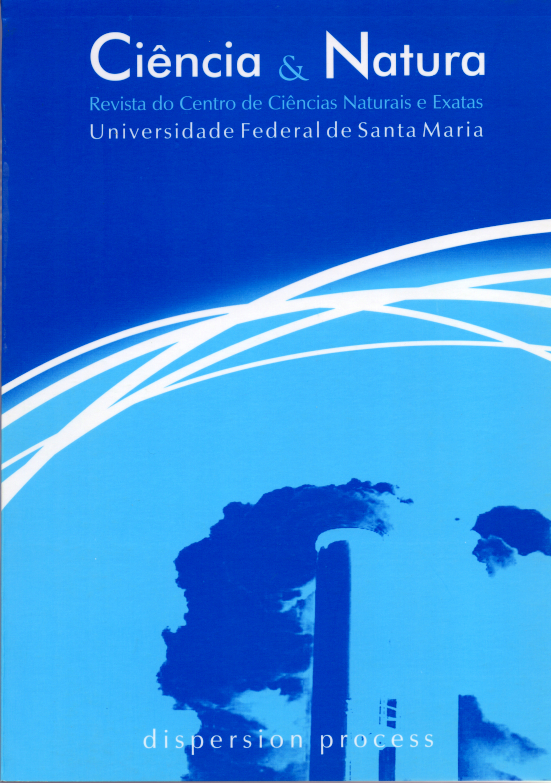A routine calculating the time dependent mixing height in coastal sites
DOI:
https://doi.org/10.5902/2179460X63621Keywords:
mixing height, turbulent fluxes, semianalytical modelling, Sodar.Abstract
The paper describes an algorithm for the calculation of the time dependent mixing height h(t) in coastal sites, using momentum and heat flux and wind and temperature time series as input data. A stationary expression for the coastal mixing height is used to avoid the solution of a partial differential equation for the evolution of h as function of time and fetch, thus reducing the problem to a direct integration in time. The algorithm has been implemented in a previously developed scheme that allows a continuous calculation over the diurnal cycle. The calculated evolution of h(t) during a few days is compared with Sodar estimates in a coastal site. Topic: Measurements of micrometeorological parameters in the planetary boundary layerDownloads
References
BELJAARS A.C.M., HOSTLAG A.A.M.,1990: A software library for the calculation of surface fluxes over land and sea. – Envir. Software, v.5 n.2, pp.60-68. DOI: https://doi.org/10.1016/0266-9838(90)90002-N
CASSARDO C., SACCHETTI D., MORSELLI M.G., ANFOSSI D., BRUSASCA G., LONGHETTO A., 1995: A study of the assessment of air temperature and sensible heat and latent heat fluxes from sonic anemometer observations. – Il Nuovo Cimento C, 4, pp.419-440. DOI: https://doi.org/10.1007/BF02511367
GRYNING S., BATCHVAROVA E., 1990: Analytical model for the growth of the internal boundary layer during onshore flow. – Q.J.R. Meteorol. Soc. 116, pp.187-203. DOI: https://doi.org/10.1002/qj.49711649108
LUHAR A.K. , 1998: An analytical slab model for the growth of the coastal thermal internal boundary layer under near neutral onshore flow conditions. Boundary Layer Meteorology, 88, pp.103-120. DOI: https://doi.org/10.1023/A:1001181605229
MARTANO P., ROMANELLI A., 1997: A routine for the calculation of the time-dependent height of the atmospheric boundary layer from surface layer parameters. Boundary Layer Meteorology, 82, pp. 105-117. DOI: https://doi.org/10.1023/A:1000108931522
STEYN D.G., OKE T.R., 1982: The depth od the daytime mixed layer at two coastal sites: a model and its validation. – Boundary-Layer Meteorol., 24, pp.161-180 DOI: https://doi.org/10.1007/BF00121666
TENNEKES H., 1973: A model for the dynamics of the inversion above a convective boundary layer. – J. Atmos. Sci., 30, pp.558-567. DOI: https://doi.org/10.1175/1520-0469(1973)030<0558:AMFTDO>2.0.CO;2
ZILITINKEVICH S.S., 1975: Comments on a paper by H. Tennekes.-J. Atmos. Sci., 32, p.991-992 DOI: https://doi.org/10.1175/1520-0469(1975)032<0991:COMFTD>2.0.CO;2
Downloads
Published
How to Cite
Issue
Section
License
To access the DECLARATION AND TRANSFER OF COPYRIGHT AUTHOR’S DECLARATION AND COPYRIGHT LICENSE click here.
Ethical Guidelines for Journal Publication
The Ciência e Natura journal is committed to ensuring ethics in publication and quality of articles.
Conformance to standards of ethical behavior is therefore expected of all parties involved: Authors, Editors, Reviewers, and the Publisher.
In particular,
Authors: Authors should present an objective discussion of the significance of research work as well as sufficient detail and references to permit others to replicate the experiments. Fraudulent or knowingly inaccurate statements constitute unethical behavior and are unacceptable. Review Articles should also be objective, comprehensive, and accurate accounts of the state of the art. The Authors should ensure that their work is entirely original works, and if the work and/or words of others have been used, this has been appropriately acknowledged. Plagiarism in all its forms constitutes unethical publishing behavior and is unacceptable. Submitting the same manuscript to more than one journal concurrently constitutes unethical publishing behavior and is unacceptable. Authors should not submit articles describing essentially the same research to more than one journal. The corresponding Author should ensure that there is a full consensus of all Co-authors in approving the final version of the paper and its submission for publication.
Editors: Editors should evaluate manuscripts exclusively on the basis of their academic merit. An Editor must not use unpublished information in the editor's own research without the express written consent of the Author. Editors should take reasonable responsive measures when ethical complaints have been presented concerning a submitted manuscript or published paper.
Reviewers: Any manuscripts received for review must be treated as confidential documents. Privileged information or ideas obtained through peer review must be kept confidential and not used for personal advantage. Reviewers should be conducted objectively, and observations should be formulated clearly with supporting arguments, so that Authors can use them for improving the paper. Any selected Reviewer who feels unqualified to review the research reported in a manuscript or knows that its prompt review will be impossible should notify the Editor and excuse himself from the review process. Reviewers should not consider manuscripts in which they have conflicts of interest resulting from competitive, collaborative, or other relationships or connections with any of the authors, companies, or institutions connected to the papers.






